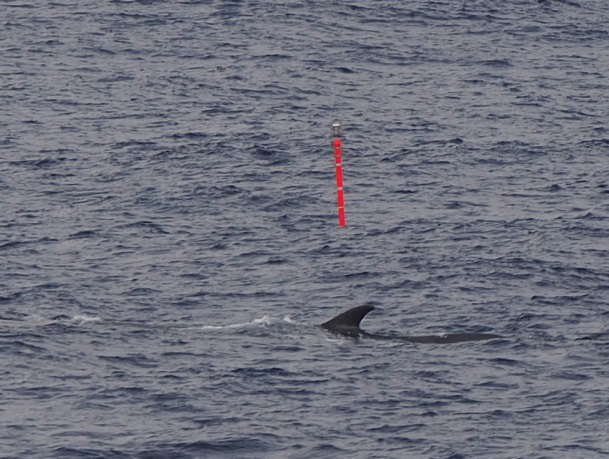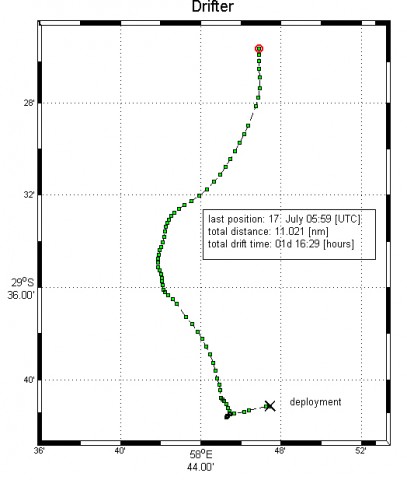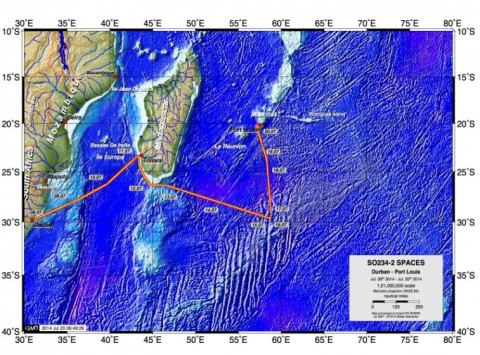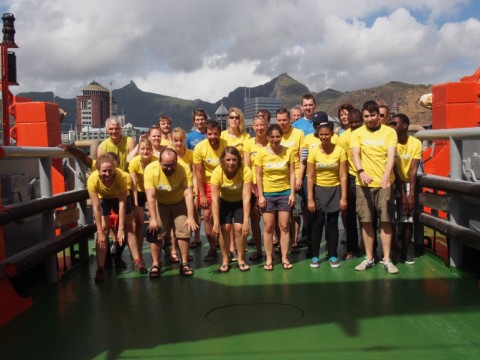14.07-20.07.2014 (Port Louis / Mauritius)
Here is the second and last weekly report from our SPACES (“Science Partnerships for the Assessment of Complex Earth System Processes”) SONNE SO234-2 cruise, a training and exchange trip between students of southern Africa and Germany, funded by the BMBF as part of the OASIS (“Organic very short-lived substances and their air-water exchange from the Indian Ocean to the stratosphere “and SO234-2 SPACES, 03G0235A) project. The daily blog (live from on board) can be followed under www.oceanblogs.org/sonne-oasis. In the second week of our training campaign, we focused on practical work as a scientist on board a research ship. On 16/07/2014 we reached approximately 29° S and 58° E, our “Drifter station”, which was in a CO2 sink in the subtropical southern Indian gyre. We stayed in the same water mass for 48 hours to investigate the chemical and biological factors that influence the trace gas exchange between the ocean and atmosphere. What does this mean in practice? RV SONNE drifted with the drifter for two full days in a southwest arc and then in a northerly direction (see Figure 1). While following the drifter, we increased the frequency of ocean profiles and atmospheric radiosonde intervals (every 6 hours), since there is not so much data in the subtropical Indian gyre.
It was the first time the students had to deal with working in shifts for 24/2. They had to choose a measurement to perform over the whole period and present it at the end of the cruise. What have they measured? Among other things, 288 Niskin bottles were filled with 3456 L seawater to investigate more than 40 parameters. Most parameters were analyzed directly on board by the students and researchers, while a lesser portion of the samples were processed and stored for later analysis in the home laboratory. The 40 parameters included measurements of halogenated and sulfur-containing short-lived substances, CO2, nutrients, DNA and pigments for identifying phytoplankton communities. The data will help later to get a better understanding of biogeochemical processes in the tropical Indian Ocean. In addition, the first ozonesonde and 6 radiosondes were launched and numerous atmospheric chemistry measurements were performed. In the following days, the students had to evaluate their own data. In groups of two, they enthusiastically prepared the interpretation of their results. Two days later, they presented their work and wrote a mini-cruise report. It is a compliment to “our” students that they walked conscientiously and diligently to action and gave very successful lectures despite the strong swell. After 11 days, 20 hours, and 2379 nm our trip ended on 07/20/2014 in Port Louis / Mauritius (Figure 2a). With a joint dinner and a formal goodbye, we reluctantly let “our” students disembark. We want to thank the SO234-2 students and scientific team and the entire team of FS SONNE for a very successful training and science cruise, and especially for the great team spirit on board … “One for all, all for one” … (Figure 2b).
Yours truly,
Kirstin Krüger (SO234-2 cruise leader), Christa Marandino (SPACES PI) and Birgit Quack (OASIS PI)



